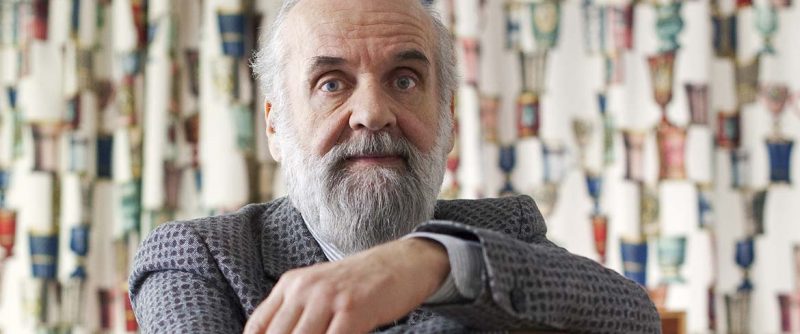Interview with Barnaba Fornasetti

The FORNASETTI Inside Out Outside In exhibition runs between June 14th, 2019 and January 26th, 2020.
Piero Fornasetti’s son, Barnaba, has managed the design house since 1982. He wants to make its art accessible to more people and is driven by his conviction that the world can be saved by beauty.
What’s the philosophy behind Fornasetti?
– With my artistic orientation, I aim to preserve a pure creativity, the intuition that arises far beyond market influences. I believe that being liberated from one’s own context has always been the secret that has made Fornasetti flourish historically – and this is more true than ever in today’s world of incessant change. One of the most important lessons I learned from my father, one that I’ve always believed in and that I resolutely uphold, is this very thing: the importance of not being swayed by passing trends. He taught me to resist conformism and ultimately I believe that this made it possible for me to always make independent decisions, which has helped the brand to preserve a clearly defined identity.
What are the major influences behind your design?
– There’s a great deal of art history in Fornasetti. Our visual language contains images from our collective imagination – shapes that have always existed in our minds and memories. My father utilised them fully to recreate a magical world – a world rich with colour and full of humour. Although he cherished an ardent desire for independence and insisted on the uniqueness of his creations, it’s easy to see that he was always well informed about the artistic developments that occurred during his lifetime. In his limitless collection of artworks, you can trace an imagery that extends from Neo-Baroque and Neo-Romantic to the surreal and metaphysical, as well as an awareness of Italy’s rich artistic tradition, paired with a deep passion for the outdated and anachronistic.
Many objects feature the face of the opera singer Lina Cavalieri – why did she become a muse for your father?
– Lina Cavalieri was an internationally acclaimed artiste who lived 1874-1944. My father never actually met her, but her face was the original spark for his creativity. Her perfect proportions and enigmatic expression were to inspire almost 400 variations over the years. As my father used to say, Lina’s face is a true archetype. The very essence of classical beauty. Just like a Greek statue and as enigmatic as the Mona Lisa. A face that could constantly be transformed in his mind.
Your father worked with the designer Giò Ponti to design furniture – what was their partnership like?
– It was a very close creative partnership and so full of happiness that Ponti once said: “If one day they write my life story, they’ll have to call one of the chapters Passion for Fornasetti.” The two of them were aligned not only on the definition and importance of decoration and the cultural heritage that it implies, but also on the whole notion of architecture – the relationship between man and his environment. Their work resulted in important concepts for interiors and furnishings, design and decoration for houses, apartments, ship cabins and cinema auditoria. It was Giò Ponti who encouraged my father to develop his intuition in order to produce everyday items embellished with the kind of decoration that would bring art into the homes of ordinary people.
You started working for the company in 1982, what was it like to work side-by-side with your father?
– In the early 1980s, 30 years after the start of his adventure, my father asked me to come to work with him. It was at that moment that I was actually handed the task of evolving this important heritage. In the years since my father’s death, I’ve found it fairly easy to preserve Fornasetti’s creative vision. I was born into this environment and my imagination has been shaped by it to such an extent that the task of taking this heritage into the future, while respecting its style, discipline and subtle irony, is something that feels natural.
How has the Fornasetti brand evolved since you took over the company after the death of your father?
– Today, I preserve and renew the tradition of craftsmanship that I inherited, revise the most popular elements and create new ones with my own style and sensitivity, in collaboration with a tight-knit and enthusiastic team. What I’ve been trying to do for some time, in parallel with the production of objects, is to liberate Fornasetti’s art from the commercial and take it in a purely cultural direction. This has resulted in the opera “Don Giovanni”, poetry readings, art exhibitions and other cultural initiatives. I would like Fornasetti to reach a wider audience beyond the world of design and make its imagery accessible to people who don’t necessarily need to purchase a product. My main motivation is the conviction that the world can be saved by beauty and most importantly by the dimension of meaning. I see that as my personal responsibility.
What are your hopes for the exhibition at Artipelag?
– It’s the first time that an exhibition devoted to the work of Fornasetti has been curated by a team from outside our own organisation. I think that it’s been a stimulating and rewarding experience. It gives a perspective that no doubt will highlight new aspects of and enrich Fornasetti’s identity.
This is an article from the Artipelag yearly magazine produced in 2019 by Make Your Mark. Text: Linus Fremin. Photo: Daniel Hertzell.